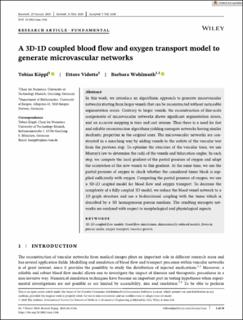A 3D-1D coupled blood flow and oxygen transport model to generate microvascular networks
Journal article, Peer reviewed
Published version

Åpne
Permanent lenke
https://hdl.handle.net/11250/2766831Utgivelsesdato
2020Metadata
Vis full innførselSamlinger
- Department of Mathematics [939]
- Registrations from Cristin [9791]
Originalversjon
International Journal for Numerical Methods in Biomedical Engineering. 2020, 36 (10), e3386. 10.1002/cnm.3386Sammendrag
In this work, we introduce an algorithmic approach to generate microvascular networks starting from larger vessels that can be reconstructed without noticeable segmentation errors. Contrary to larger vessels, the reconstruction of fine-scale components of microvascular networks shows significant segmentation errors, and an accurate mapping is time and cost intense. Thus there is a need for fast and reliable reconstruction algorithms yielding surrogate networks having similar stochastic properties as the original ones. The microvascular networks are constructed in a marching way by adding vessels to the outlets of the vascular tree from the previous step. To optimise the structure of the vascular trees, we use Murray's law to determine the radii of the vessels and bifurcation angles. In each step, we compute the local gradient of the partial pressure of oxygen and adapt the orientation of the new vessels to this gradient. At the same time, we use the partial pressure of oxygen to check whether the considered tissue block is supplied sufficiently with oxygen. Computing the partial pressure of oxygen, we use a 3D-1D coupled model for blood flow and oxygen transport. To decrease the complexity of a fully coupled 3D model, we reduce the blood vessel network to a 1D graph structure and use a bi-directional coupling with the tissue which is described by a 3D homogeneous porous medium. The resulting surrogate networks are analysed with respect to morphological and physiological aspects.
